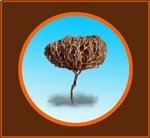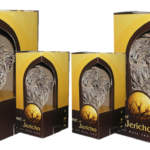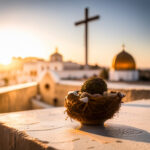The real Rose of Jericho
The Flower of Maryam

This plant called also Maryam boti and the Real Rose Of Jericho or the botanical name Anastatica hierochuntica.
The plant have a lot of names in several language’s
Hebrew – שושנת יריחו האמיתית
Arabic: Keff Maryam (كف مريم), shajarat Maryam (شجرة مريم), shajarat el-talk, keff lala Maryam, keff lala Fatma, yid Fatma, keff el-adhra, bint Ennabi, el-kemcha, kerchoud
Berber: Tamkelt
English: Flower of Maryam, St. Mary’s flower, resurrection plant, true rose of Jericho (not to be confused with false rose of Jericho, Selaginella lepidophylla), tumbling mustard, resurrection mustard
French: Main de Fatma, rose de Jericho
Malay: Sanggul Fatimah, buah zuriat (“offspring fruit”)
Persian: Gole Maryum, پنجه مریم , Panjeh Maryam
Turkish: Fatima’nin eli, Meryem bitkisi
Urdu: Maryam booti, Maryam ka phool, Nabi booti
What is the use of a bitter flower?
It is estimated that Maryam helps during childbirth – in the baby’s birth process. It is said that the leaves are also used to strengthen the uterus and are good for conception. The leaves of this herbal plant available grow in the Mediterranean area of the Judean Desert near the city of Jericho in the Land of Israel where, according to legend, Miriam met the plant for the first time and blessed it.
among its most popular medicinal uses is its application for childbirth. Whether its medicinal properties encourage dilation, or if it’s a powerful visualization tool for mothers, traditional midwives have used the Flower of Maryam with their laboring mothers for hundreds of years.
it is referred to as the “leaf of Maryam” (mother of Jesus), the “hand of Fatima” (daughter of the Prophet ﷺ), as well as simply “daughter of the Prophet ﷺ,” and “resurrection plant.” It is referenced in the Bible in II Kings 19:34-36 and in Psalms 83:13, “make them like tumbleweed,” here referring to the dried twiggy balls of Anastatica that disperse in the wind, scattering its seeds.
It also contains a number of elements useful for pregnancy and labor, including calcium, magnesium, potassium, zinc, and iron; in particular, calcium and magnesium work together to coordinate and regulate smooth muscle contractions.
Medicinal preparation
It is reconstituted in water and taken internally for colds, as an emmenagogue, for epilepsy, uterine hemorrhage, and to bring pain relief and support for childbirth. In some places, it is burned as an incense during labor, made into a powder mixed with olive oil and honey and applied to pregnant women.
used in Europe Christmas celebrations. In Malaysia, it is commonly used for childbirth
s a medicinal preparation, it is reconstituted in water and taken internally for colds, as an emmenagogue (herbs generally meant to bring on period/ menstruation), for epilepsy, uterine hemorrhage, and to bring pain relief and support for childbirth.
In some places, it is made into a powder – mixed with olive oil and honey, and as a liquid from fresh leaves – is used as a treatment for conjunctivitis and other problems of the eye. It is also used medicinally in countries where it does not grow; in Malaysia, it is commonly used for childbirth, where many women purchase herbal preparations directly from the traditional midwives.
The flower contains a number of elements – calcium, magnesium, potassium, zinc, and iron; in particular, calcium and magnesium work together to coordinate and regulate smooth muscle contractions. The soaked water can be drunk. The plant can be stored and re-used many times over.
This herb is commonly consumed by women during pregnancy, particularly close to delivery because it is believed to ease the process of childbirth. It has also been used in the treatment of reproductive system-related disorders such as menstrual cramps and uterine haemorrhage (Daur, 2012;Kim Sooi and Lean Keng, 2013;Shah et al., 2014) and is also claimed to be beneficial in antepartum care ( Law et al., 2009).
Others use it as an alternative treatment for diabetes mellitus, gastric disorder ( Shah et al., 2014), epilepsy, arthritis, malaria, mental depression, mouth ulcers, bronchial asthma and as an analgesic (Daur, 2012;Eman et al., 2011;Jaradat, 2005;Kim Sooi and Lean Keng, 2013 and hypolipidaemic properties are supported by scientific studies (Mohamed et al., 2010;Shaban et al., 2011). …
It has also been used in the treatment of reproductive system-related disorders such as menstrual cramps and uterine haemorrhage (Daur, 2012;Kim Sooi and Lean Keng, 2013;Shah et al., 2014) and is also claimed to be beneficial in antepartum care ( Law et al., 2009).
Others use it as an alternative treatment for diabetes mellitus, gastric disorder ( Shah et al., 2014), epilepsy, arthritis, malaria, mental depression, mouth ulcers, bronchial asthma and as an analgesic (Daur, 2012;Eman et al., 2011;Jaradat, 2005;Kim Sooi and Lean Keng, 2013 and hypolipidaemic properties are supported by scientific studies (Mohamed et al., 2010;Shaban et al., 2011). Anastatica hierochuntica extracts were also reported to have hepatoprotective, anti-inflammatory and anti-melanogenic activities ( Nakashima et al., 2010;Rizk et al., 1985;Yoshikawa et al., 2003)







